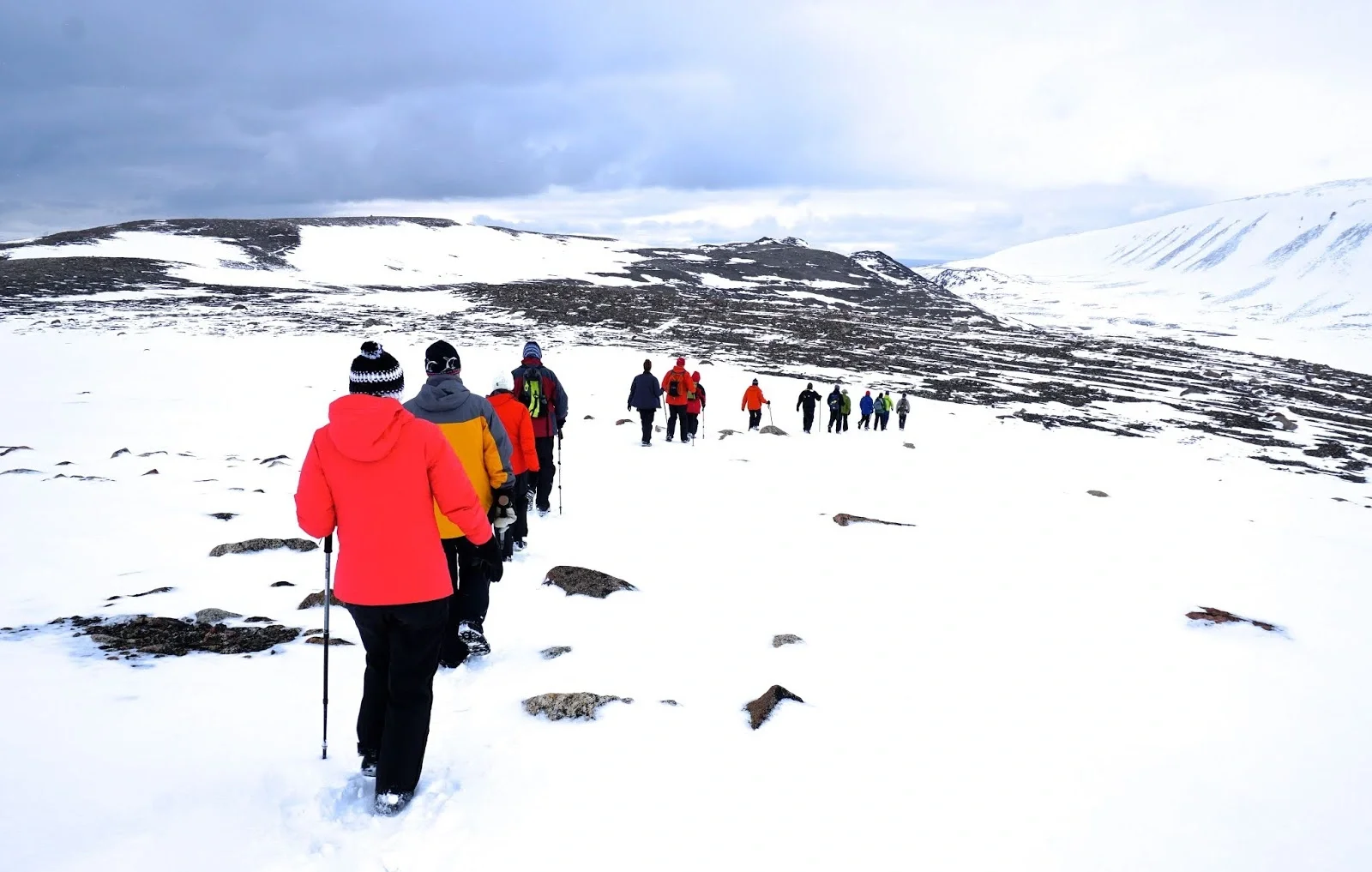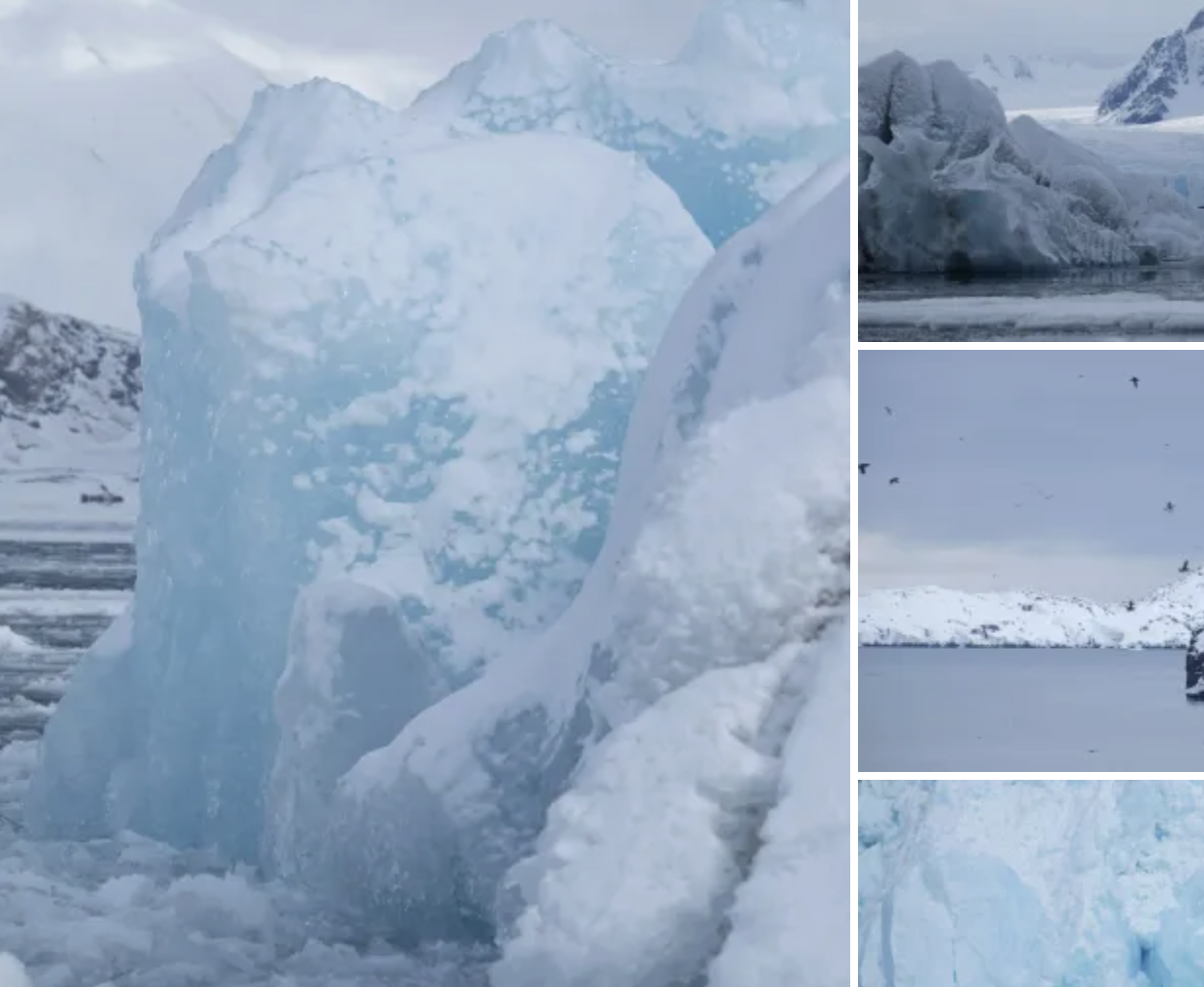Land of the Polar Bears
Everyone is an explorer at heart! Svalbard is an entirely atypical refuge in the high Arctic that abounds with an extraordinary array of wildlife. Few places in the circumpolar region can match the bio density of Svalbard and, polar bears thrive there.
I embarked on the National Geographic Explorer, an ice-class vessel that allows us to probe the seas searching for resident wildlife, including walruses, seals, and the majestic polar bear – the very symbol of the Arctic. I discovered the unusual Arctic flora and tidewater glaciers on walks with naturalists and spot huge walruses, bearded and ringed seals, artic foxes and reindeer. Experiencing the legendary midnight sun: the ethereal light of the northern summer, when the sun never sets was not easy to adjust to. Thank goodness for blackout drapes!
Land of the Polar Bears is a voyage undertaken in the spirit of discovery and is exploratory by design. In a region ruled not by humans but by polar bears. Nature was our guide. Aboard the National Geographic Explorer ship, we probed the ice in search of wildlife; our exact day-to-day itinerary remained flexible, depending on local ice and weather conditions. Zodiacs and kayaks took us closer to experience the region’s geologic features and wildlife and wildflowers that flourish during the summer months. The Liken was blooming on the rocks in vibrant shades of orange, pink and purple.
Every day the National Geographic photographer and a seasoned naturalist staff were with me us as I ventured to the foot of stunning tidewater glaciers, kayaked among sparkling icebergs, and explored fjords that split the rugged coastlines. We hiked through miniature gardens blooming on the tundra in search of polar bears, walruses, seals, reindeer and arctic foxes. Svalbard is one of the best places on the planet to observe majestic polar bears in their natural environment.
Did you know:
The warmest day in Longyearbyen in 2017 was Sept. 26 when it was 55.9 degrees Fahrenheit. That is the latest date a heat record for a year has been set.
The warmest day ever was in July of 1979 when it was 70.3 degrees.
The coldest day in 2017 was March 18 when it was minus 10.3 degrees.
The all-time record low occurred in March of 1986 when it was minus 51.3 degrees.
Longyearbyen, Svalbard
Tell me, what is you plan to do with your one wild and precious life. –Mary Oliver
As we begin our voyage, it is apparent that we will share the beauty and uniqueness of the High Arctic of Svalbard. The cruise ship, National Geographic Explorer, features an open bridge which was a great place for a very beautiful view all day long. We visited the bridge quite often during the cruise. We were alerted at every polar bear sighting even at 2am.
Krossfjorden, Svalbard
A first walk in any new country is one of the things which makes life on this planet worth being grateful for. –Charles William Beebe
On the second day, we are in Krossfjorden, Svalbard. The name Spitsbergen means “jagged peaks” and is one of three inhabited islands in the archipelago. The largest settlement on Spitsbergen is the Norwegian town of Longyearbyen.
As we cruised into the large fjord system: Krossfjorden and its neighbor, Kongsfjorden. We saw large fjords. Alpine in character, the area has very active glaciers and forks into many smaller fjords and bays. Warmed by the North Atlantic Drift, the waters of the west coast are relatively ice-free in summer, and temperatures are generally warmer than the icebound east coast. It is magnificent.
Hinlopen Strait, Svalbard
You know, once something freezes, it’s solid. That’s the key to the Arctic – they didn’t fear the cold, they made use of it. –Wade Davis
The Hinlopen Strait separates the two largest islands of the Svalbard archipelago. The cape is marked by high cliffs, which host one of the largest concentrations of nesting seabirds in Svalbard. The geological setting of the cape is completely unique.
Today, the announcement was made that our shore land was to be cancelled due to fog in the atmosphere. However, we saw our first polar bear of the trip! I raced to the bridge as the ship slowly and quietly approaches shoreline. The polar bear is majestic. It is not white, it is off-white and yellowish in hue. Its huge paws are the size of dinner plates. It’s special to share the experience with others on board. I am in awe. All ship passengers are warned to be silent. You don’t want to be responsible for scaring away the bear with the sound of a loud tour.
Polar bears are marine mammals that weigh up to 2000 lbs. They are the largest land carnivores in the world, rivaled only by the Kodiak brown bears of southwestern Alaska. Polar bears sit at the top of the food chain in the biologically rich Arctic. The most carnivorous of the bear species, polar bears feed primarily on the fat of ice-dependent seals. They are also known to eat walrus, beluga whale and bowhead whale carcasses, birds’ eggs, and (rarely) vegetation. Polar bears travel great distances in search of prey. We saw a bear leap at this walrus only to be discouraged by their huge size and tusks.
The World Conservation Union (IUCN) estimates that there are between 20,000-25,000 polar bears in the world, of which 3,000 are in Longyearbyen. Polar bears are only found in the Arctic and can smell a seal up to 32 kilometers away. The most important habitats for polar bears are the edges of pack ice where currents and wind interact, forming a continually melting and refreezing matrix of ice patches and leads (open spaces in the ocean between sea ice). These are the areas of where polar bears can find the greatest number of seals. Polar bears can walk 8,000 meters in a year and up to 50 meters a day. They are highly dependent on older stable pack ice in the Arctic region, where they spend much of their time on the ice hunting, mating and denning.
Woodfjorden, Svalbard
The grand show is eternal. It is always sunrise somewhere. The dew is never dried at once. A shower is forever falling; vapor is ever rising. Eternal sunrise, eternal sunset. Eternal dawn and glowing, on sea and continents and islands, each in its turn as the earth rolls. All for this I am forever grateful to be alive. –John Muir
The next morning we reached Moffen Island, a small island just to the North of Spitsbergen. The island sometimes has wildlife on it and is a protected area. We arrive by 6:00A and a short PA announcement is made to allow us time to get up and come to the Bridge to view the wildlife. The polar bears and walruses are the main attractions of the Arctic. It feels more like an African safari, as we “find” the wildlife and approach the animals very slowly and quietly so we do not scare them. We saw many large walruses floating on ice. Walruses are the gentle giants of the Arctic. They are among the largest pinnipeds — fin-footed, semiaquatic marine mammals. However, while they have an intimidating size, and are carnivores, these animals are not aggressive. Walruses have large, flabby bodies covered in brown or pink skin. Short fur covers most of their bodies except for their fins. Their faces feature two small eyes, a mustache and two long tusks and can weigh from 1,320 to 3,300 lbs.
Next, we head south into a large and very scenic fjord called Woodfjorden. In the afternoon, we explored a large arm of Woodfjorden probably named after a ship “de Liefde” (Dutch for Love). The fjords offer very impressive scenery. The landings are about experiencing the terrain. We encountered a couple of reindeer still in their winter white while we were on a 2-mile hike. The ice was deep and misleading
Seven Islands, Svalbard
The North is the only place where Nature can still claim to rule, the only place as yet but little vexed by man. All over the globe there spread his noisy failures; the North alone is silent and at peace. –Stephen Leacock, 1937
This morning the National Geographic Explorer cruised further north and east, crossing 80degree N as we approach the island of Phippsoya, located off the northwest coast of Nordaustlandet (North East Land). We hiked and walked, exploring the island along the shore with the guide. These islands are the most northerly points in the Svalbard Archipelago.
Seven Islands is a small archipelago situated north of Nordaustlandet. The largest island has a maximum elevation of 1,296 feet above sea level. It is more than 660 nautical miles north of Nordkapp, the northern tip of continental Norway. Bedrock of the Seven Islands archipelago comprises a series of deformed and metamorphosed granites and metasedimentary rocks that formed approximately 1,800 million years ago.
The wildlife seen here ranges from the black and white guillemots to puffins with orange feet and clown-like faces. The guillemots are referred to as the ‘penguins of the north’. They are better at swimming than at flying and they too are dressed in tuxedos for a formal dinner.
Far North, Svalbard
Today was a day of exploration. The Far North is an area almost never explored by expedition vessels, especially at this time of year. We continue to follow an ice edge as indicated by ice charts in the morning. In the afternoon, we travel back on the northern cost of Nordaustlandet. Our exact landing site was dependent on weather and ice conditions.
Normally, there is a block of solid ice from 8 to 10 feet. As we sailed further North, the look of despair on the captains face said it all. There were no blocks of frozen ice. Just blocks of broken ice and ice sheets, all evidence of global warming – heart breaking.
Fuglefjorden and at Sea, Svalbard
Strange. There is always sadness on departure. It is as if one cannot after all bear to leave this bleak waste of ice, glaciers, cold and toil… -Fridtjof Nansen, 1912
We enter Fuglefjorden, an area with stunning scenery and a beautiful glacier at the end of the fjord. Today, the conditions enable us to explore the area with Zodiac cruising. On the Zodiac cruises, we encounter a baby seal who was split from its mother. It swims close to our Zodiac, wanting interaction and to come aboard the boat.
The trip concludes with so many breathtaking moments at all times of the day. The views from the balcony are an incredible sight to see. The whale sightings are far too many to count. The National Geographic Land of the Polar Bears journey was one for the books. I end this journey with a renewed commitment to protect the planet.





